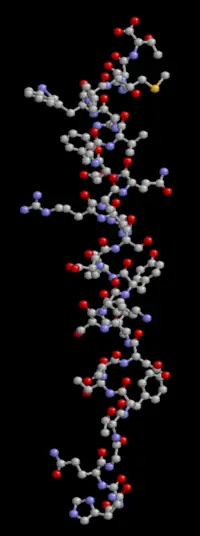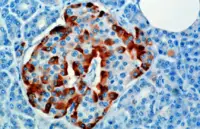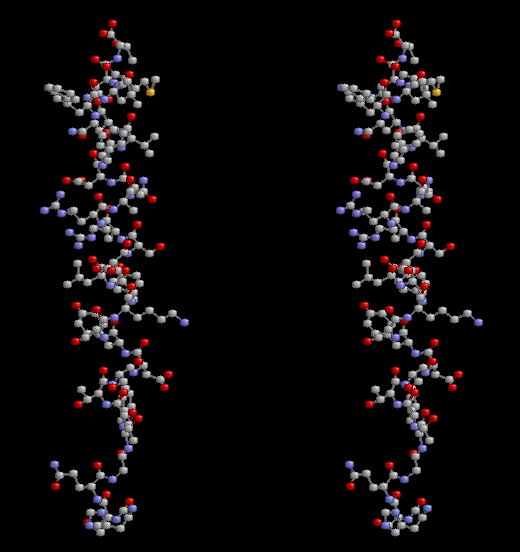Glucagon
Glucagon is an important protein hormone of the endocrine system, produced by the alpha cells of the islets of Langerhans in the pancreas of vertebrates. One of its key functions is to increase blood sugar levels by stimulating the breakdown of liver glycogen to sugar (glycogenolysis), preventing the liver from storing glucose, increasing glucose formation in the liver from dietary protein (amino acids) and fats, and increasing release of glucose from the liver into the blood (Bender and Bender 2005; MedNet 2001).
Glycogen is the principal storage form of glucose in animal cells. It is a large, branched polymer of linked glucose residues (portions of larger molecules) that can be readily mobilized as an energy source, increasing the amount of glucose immediately available to the organism between meals and during muscular activity. Since the brain relies on glucose as its preferred fuel, the ability to maintain a steady supply of glucose, which is the major sugar circulating in the blood of higher animals, is crucial to survival.
The action of glucagon is opposite to that of insulin, which instructs the body's cells to take in glucose from the blood in times of satiation. The system involving these two hormones tend to balance each other. Just as Yin and Yang in Oriental philosphy are opposing, yet complementary and interdependent forces, the systems involving glucagon and insulin complement each other and are both necessary to create overall harmony and balance in the living organism.
History
In the 1920s, Kimball and Murlin studied pancreatic extracts and found an additional substance with hyperglycemic properties. They described glucagon in 1923.[1] The amino acid sequence of glucagon was described in the late-1950s.[2] A more complete understanding of its role in physiology and disease was not established until the 1970s, when a specific radioimmunoassay was developed.
Structure
Glucagon is a 29-amino acid polypeptide. Its primary structure in humans is: NH2-His-Ser-Gln-Gly-Thr-Phe- Thr-Ser-Asp-Tyr-Ser-Lys-Tyr-Leu-Asp-Ser- Arg-Arg-Ala-Gln-Asp-Phe-Val-Gln-Trp-Leu- Met-Asn-Thr-COOH.
The polypeptide has a molecular weight of 3485 daltons.
Physiology
Production
The hormone is synthesized and secreted from alpha cells (α-cells) of the islets of Langerhans, which are located in the endocrine portion of the pancreas. The alpha cells are located in the outer rim of the islet.
Regulatory mechanism
Increased secretion of glucagon is caused by:
- Decreased plasma glucose
- Increased catecholamines - norepinephrine and epinephrine
- Increased plasma amino acids (to protect from hypoglycemia if an all protein meal consumed)
- Sympathetic nervous system
- Acetylcholine
- Cholecystokinin
Decreased secretion of glucagon (inhibition) is caused by:
- Somatostatin
- Insulin
Function
Glucagon helps maintain the level of glucose in the blood by binding to glucagon receptors on hepatocytes, causing the liver to release glucose - stored in the form of glycogen - through a process known as glycogenolysis. As these stores become depleted, glucagon then encourages the liver to synthesize additional glucose by gluconeogenesis. This glucose is released into the bloodstream. Both of these mechanisms lead to glucose release by the liver, preventing the development of hypoglycemia.
- Increased free fatty acids and ketoacids into the blood
- Increased urea production
Mechanism of action
Glucagon binds to the glucagon receptor, a G protein-coupled receptor located in the plasma membrane. The conformation change in the receptor activates G proteins, a heterotrimeric protein with alpha, beta and gamma subunits. The subunits breakup under GTP hydrolysis and the alpha subunit specifically activates the next enzyme in the cascade, adenylate cyclase.
Adenylate cyclase manufactures cAMP (cyclical AMP) which activates protein kinase A (cAMP-dependent protein kinase). This enzyme in turn activates phosphorylase B kinase, which in turn, phosphorylates phosphorylase B. Phosphorylase B is the enzyme responsible for the release of glucose-1-phosphate from glycogen polymers.
Pathology
Abnormally-elevated levels of glucagon may be caused by pancreatic tumors such as glucagonoma, symptoms of which include necrolytic migratory erythema (NME), elevated amino acids and hyperglycemia. It may occur alone or in the context of multiple endocrine neoplasia type 1.
Uses
An injectable form of glucagon is vital first aid in cases of severe hypoglycemia when the victim is unconscious or for other reasons cannot take sugar orally. The dose for an adult is typically 1 milligram, and the glucagon is given by intramuscular injection, and quickly raises blood glucose levels. Glucagon can also be administered IV at 0.25 - 0.5 unit.
Anecdotal evidence suggests a benefit of higher doses of glucagon in the treatment of overdose with beta blockers; the likely mechanism of action is the increase of cAMP in the myocardium, effectively bypassing the inhibitory action of the β-adrenergic second messenger system.[3]
Glucagon acts very quickly: common side effects include headache and nausea.
Media
|
|
References in pop culture
- American parodist "Weird Al" Yankovic released a song entitled Pancreas on his album Straight Outta Lynwood, which uses the lyric "Insulin, Glucagon, flowing from the Islets of Langerhans" as a repeated catchy chorus in the final minute of the song.
ReferencesISBN links support NWE through referral fees
- ↑ Kimball C, Murlin J. Aqueous extracts of pancreas III. Some precipitation reactions of insulin. J Biol Chem 1923;58:337-348. PDF fulltext.
- ↑ Bromer W, Winn L, Behrens O. The amino acid sequence of glucagon V. Location of amide groups, acid degradation studies and summary of sequential evidence. J Am Chem Soc 1957;79:2807-2810.
- ↑ White CM. A review of potential cardiovascular uses of intravenous glucagon administration. J Clin Pharmacol 1999;39:442-7. PMID 10234590.
http://www.medicinenet.com/glucagon/article.htm Glucagon
2001
MedNet
- Bender, D. A., and A. E. Bender. 2005. A Dictionary of Food and Nutrition. New York: Oxford University Press. ISBN 0198609612.
See also
| Hormones and endocrine glands - edit |
|---|
|
Hypothalamus: GnRH - TRH - CRH - GHRH - somatostatin - dopamine | Posterior pituitary: vasopressin - oxytocin | Anterior pituitary: GH - ACTH - TSH - LH - FSH - prolactin - MSH - endorphins - lipotropin Thyroid: T3 and T4 - calcitonin | Parathyroid: PTH | Adrenal medulla: epinephrine - norepinephrine | Adrenal cortex: aldosterone - cortisol - DHEA | Pancreas: glucagon- insulin - somatostatin | Ovary: estradiol - progesterone - inhibin - activin | Testis: testosterone - AMH - inhibin | Pineal gland: melatonin | Kidney: renin - EPO - calcitriol - prostaglandin | Heart atrium: ANP Stomach: gastrin | Duodenum: CCK - GIP - secretin - motilin - VIP | Ileum: enteroglucagon | Liver: IGF-1 Placenta: hCG - HPL - estrogen - progesterone Adipose tissue: leptin, adiponectin Target-derived NGF, BDNF, NT-3 |
Template:Proglucagon
Credits
New World Encyclopedia writers and editors rewrote and completed the Wikipedia article in accordance with New World Encyclopedia standards. This article abides by terms of the Creative Commons CC-by-sa 3.0 License (CC-by-sa), which may be used and disseminated with proper attribution. Credit is due under the terms of this license that can reference both the New World Encyclopedia contributors and the selfless volunteer contributors of the Wikimedia Foundation. To cite this article click here for a list of acceptable citing formats.The history of earlier contributions by wikipedians is accessible to researchers here:
The history of this article since it was imported to New World Encyclopedia:
Note: Some restrictions may apply to use of individual images which are separately licensed.


